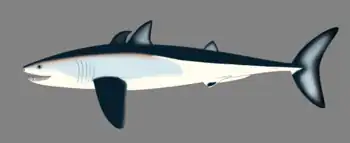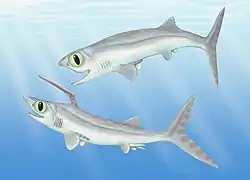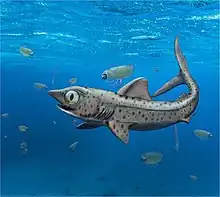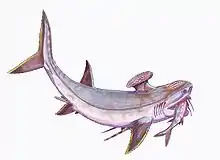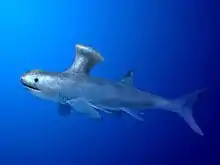Symmoriiformes
Symmoriiformes is an extinct order of stem-group holocephalians.[1] Originally named Symmoriida by Zangerl (1981),[2] it has subsequently been known by several other names. Lund (1986) synonymized the group with Cladodontida, while Maisey (2008) corrected the name to Symmoriiformes in order to prevent it from being mistaken for a family.[3] The symmoriiform fossils record begins during the late Devonian. Most of them died out at the start of the Permian, but Dwykaselachus is known from the Artinskian-Kungurian of South Africa.[1] Teeth described from the Valanginian of France[4] and Austria[5] indicate that members of the family Falcatidae might have survived until the Early Cretaceous; however, these teeth were also argued to be more likely neoselachian teeth.[6]
| Symmoriiformes Temporal range: Late Devonian - Early Permian (Members of the family Falcatidae might have survived until the Early Cretaceous in Europe.) | |
|---|---|
 | |
| Symmorium | |
| Scientific classification | |
| Domain: | Eukaryota |
| Kingdom: | Animalia |
| Phylum: | Chordata |
| Class: | Chondrichthyes |
| Subclass: | Holocephali |
| Order: | †Symmoriiformes Zangerl, 1981 (sensu Maisey, 2007) |
| Families and genera | |
Fossil distribution
Fossil evidence of Symmoriida have been found at Bear Gulch, Fergus County, Montana,[7] Bethel Quarry, Pike County, Indiana, Kinshozan quarry, Alaska, Gifu Prefecture, Japan, Bashkortostan, Russian Federation[8] and possibly also France.
Classification
The symmoriiformes have been assigned to Cladoselachii by Goto et al. (1988), to Elasmobranchii by Williams (1998), and to Chondrichthyes by Sepkoski in 2002 and by Maisey in 2008.
The uncrushed braincase of Dwykaselachus indicates that symmoriiforms are members of Holocephali, as much of the internal anatomy, including the otic labyrinth and brain space configuration are similar to those of chimaeras. They were placed as early diverging holocephalans, with all other holocephalans more closely related to each other than they are to Symmoriiformes.[1]
Gallery
References
- Coates M.; Gess R.; Finarelli J.; Criswell K.; Tietjen K. (2016). "A symmoriiform chondrichthyan braincase and the origin of chimaeroid fishes". Nature. 541 (7636): 208–211. doi:10.1038/nature20806. PMID 28052054. S2CID 4455946.
- Zangerl, R. (1981). Chondrichthyes I – Paleozoic Elasmobranchii. Handbook of Paleoichthyology. Stuttgart: Gustav Fischer Verlag. pp. i–iii, 1–115.
- Maisey, John G. (31 October 2007). "The braincase in Paleozoic symmoriiform and cladoselachian sharks". Bulletin of the American Museum of Natural History. 307: 1–122. doi:10.1206/0003-0090(2007)307[1:TBIPSA]2.0.CO;2. S2CID 85643864.
- Guillaume Guinot; Sylvain Adnet; Lionel Cavin & Henri Cappetta (2013). "Cretaceous stem chondrichthyans survived the end-Permian mass extinction". Nature Communications. 4: Article number: 2669. doi:10.1038/ncomms3669. PMID 24169620.
- Feichtinger, Iris; Engelbrecht, Andrea; Lukeneder, Alexander; Kriwet, Jürgen (2020-07-02). "New chondrichthyans characterised by cladodont-like tooth morphologies from the Early Cretaceous of Austria, with remarks on the microstructural diversity of enameloid". Historical Biology. 32 (6): 823–836. doi:10.1080/08912963.2018.1539971. ISSN 0891-2963. S2CID 92392461.
- Alexander O. Ivanov (2022). "New late Carboniferous chondrichthyans from the European Russia". Bulletin of Geosciences. 97 (2): 219–234. doi:10.3140/bull.geosci.1845. S2CID 249479522.
- Lund R (1982). "Harpagofututor volsellorhinus new genus and species (Chondrichthyes, Chondrenchelyiformes) from the Namurian Bear Gulch Limestone, Chondrenchelys problematica Traquair (Visean), and their sexual dimorphism". Journal of Paleontology. 56 (4): 938–958., authorized by John Alroy, Paleobiology Database: Bear Gulch site
- Ivanov A (2005). "Early Permian chondrichthyans of the middle and south Urals". Revista Brasileira de Paleontologia. 8 (2): 127–138. doi:10.4072/rbp.2005.2.05.
